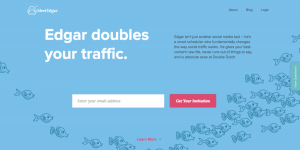You know one of the worst things about social media? It’s the fact that it is so easy to get sucked into it. If you’re running a business and you spend any amount of time on social media, you’ll soon realize that it can take hours out of your day if you’re not careful.
That’s why you need a plan, a strategy.
We know that social media is a huge time sink if you’re not organised, so we’ve put together a list of 9 things you can do (with some automation ideas) that should help you keep your head above water, and out of the heady mess that social media can be.

By all means dive into social, but take a few pointers from here and it should bring you results without killing your week.
Tip one: Bank your content.
This is one of the most important aspects of managing social well. If you are looking at trying to make headway, the last thing you need to do is to be making it up on the spot every week. Work with the people in your team and try to find a way to bank content.
This means putting together a large chunk of content that you can dip into and send out on your various platforms, for example. If you get together a group of tweets at one point every week, and then just make sure they get out at the appropriate time, you’re winning. The worst thing is to sit there and try and find some tweets ‘on the spot’.
The same goes for your other platforms, Instagram and Facebook for example. Spend some time brainstorming the content you want to get out there, build up a bank every week and that means that a huge portion of your week is saved.
We recommend Monday for banking content, and then the rest of the week is your friend.
Tip two: Use social media as a customer service platform.
Not too many companies get this right, sadly. Social media is one of the best and most natural ways to talk to customers about anything that bothers them. Or it can simply be a way to answer questions that they may have. But it is still underused by a large number of businesses, who simply don’t tap into the excellent customer service potential of platforms like Facebook and Twitter.
People will use social media to talk about your business if they want to, so it is the perfect place to manage customer service. Hopping on there for just a few minutes every day can take the place of a traditional customer service team manning phone lines. But even better, it can save time in one crucial way.
If a customer service meltdown occurs, and your company faces a major issue because you didn’t respond to a complaint or spot a problem before it mushroomed, you can spend days and even months trying to fix things. Avert this, and listen to your customers through social media, and you are looking at a solution that allows you to save hours, days, weeks (and more) of precious time trying to patch up a disaster.

Some companies provide a truly inspirational example or two of social media customer service. But even if you can’t dedicate a specialist team on social, you can still save time by putting in a little bit every day. Disasters are a lot more time-consuming to fix than a simple response on Twitter, for example.
Tip three: Get alert.
We’re not talking about being more awake (well, in a way we are) but instead switching on to your industry and ensuring that it is talking to you. There are many ways to do this, but to understand why you have to do this just bear in mind that there are millions of blog posts written every day. We thought we’d take a look at the actual numbers here and then we had to shut the window down in our browser because we felt a little dizzy.
With that many blog posts being written per day, there are bound to be thousands written within your industry. That means there is a ton of content and ideas out there that is relevant to you. While not all of that content is going to be good, you still need to be plugged into the conversation. If your social media relies on repurposing content or spreading the news (which is the case for everyone) then you need to find a way to have the best of that huge body of content delivered to you.
There are many ways to do this, but one of the best is the good old Big G. Google has provided news alerts every day to anyone who subscribes to its news service, and this is still one of the very best ways to recieve content ideas and news feeds.

You can also tap into services like Feedly. By identifying which areas you are interested in, you can have an almost endless supply of topic ideas for social media content.
This helps you save time because it allows you to have the content ideas come to you, rather than you searching for them. So get alert(ed).
Tip four: Save content ideas in a special place.
As you start to build up an awareness of what is going on your industry and you’re beginning to build up ideas for themes and directions, you’re going to be exposed to a lot of content. Keeping all of that content in one place is essential.
There are some ways in which you can save articles in one place so that you can go back to them for your content inspiration. An old-school (but still very useful) way is to simply open up a spreadsheet and store URLs of content that you want to read at a later date. This doesn’t take much time to do.
Or you could simply bookmark content in folders on your browser. This saves time because you don’t have to keep exploring your browser to try to find content that you were attracted to and need to re-visit. Using browser bookmarks in folders is still a top notch way of keeping tabs on valuable posts you want to read, for example, but don’t have time to at the moment.
A service called Pocket is also a good way to store up the content you want to come back to. This has a folder function and allows you to store with tags. The outcome? You’re storing content in a safe place, so that when you want to add even more value to your social you have a collection of good ideas and topics you can draw inspiration from, link to, and curate.

Tip five: Cut down.
This is another one that companies can find difficult. The problem with social media is that it is, to an extent, free. This means there are no real barriers to entry, and that there is consequently a need to be everywhere and on every platform. But this doesn’t make sense, and pretty soon it results in overload, with businesses spending all of their time on numerous platforms, and not making any real headway at all.
Choose the platforms that make sense for your business and its audience, and then look at the resources you have. If you have a large team of people for social media, then by all means allocate them to various platforms (keeping in mind the concept of being on platforms only if they are relevant to you and your audience).
If, however, you have only limited resources to spend (time and effort wise) on social media, there is nothing wrong with devoting time to just one or two platforms to start with.
You may even find a platform that works well for you and brings you leads without any need for other channels.

Just don’t spread yourself too thin. It just wastes time in the end and results in overload. Focus your time and efforts and you will simply end up saving time that you can use elsewhere in your business.
Check our guide to find out which social media platform is right for you.
Tip six: Look at the analytics and get rid of the deadwood.
This is an interesting tip because it is almost too obvious. If you have a handle on your social media metrics, you should be able to work out, quite quickly, which platforms are worth staying on board with, and which are worth ditching.
Your metrics can outline where your investment in time and money is paying off. You can see follower and engagement growth, for example, and work out if all that time you’re investing in Twitter is worthwhile or needs reducing a little. A good social media dashboard allows you to keep up on key indicators such as engagement and reach, so you know just how effective your work is on social.
It can help you figure out which post formats perform better, like video as opposed to text links, for example.
It’s all good. And it ensures that you can reduce or remove wastage, keeping your social media work lean and mean, as well as productive.

Try Locowise for example in order to build a custom dashboard for your own activities and have analytics for multiple profiles from multiple platforms all in one easy-to-view and understand page.
Tip seven: Use video. A lot.
Video is simpler to organise than text-heavy posts that take up a lot of time. If you are suffering time wise with social media and it’s starting to suck away at your energy, get a few videos made.
If you run a business yourself, use just you in the video, answering people’s questions. It doesn’t take a lot of time to do (just a little planning) and you can enjoy yourself a lot more because everyone likes getting involved in video.
Video makes a lot of sense if social media is taking up your time. Pick a few questions and record a series of videos answering them and you have a lot of shareable social media content, ready to go.

Tip eight: Know who you’re talking to and where to find them.
You could save a whole lot of time with this one. If things aren’t taking off on social media, then you need to sit back and focus on your ideal customer(s). Knowing who they are and what makes them tick will allow you to focus your efforts much more effectively.
If your ideal customer is a CEO of a medium to large-sized company, head over to LinkedIn and stop wasting your time elsewhere. If you are a B2C company that makes products, consider Instagram or Pinterest. Think about who your ideal customer is and cut out all that time wasting by being in the right place, and talking to the right people.
Tip nine: Automate, automate.
Getting back to those metrics, a good metrics dashboard will also allow you to automate reporting. If you are a social media manager you will know the pain involved in reporting data to stakeholders. However, a strong social media dashboard removes that problem by creating custom reports and sending them out at specified times, to specified people.
That means you can arrange the kind of reports that are meaningful to you and your business, and ensure they get sent out regularly to the right people. Automation is perhaps the key differentiator between a poor quality metrics platform and a great one.
The key takeaways
Here, we think the main ideas are that you automate as much as possible, make sure you’re not wasting time and effort, and try to be doing only what is useful in social media. It’s very easy to get sucked into it, but if it’s doing nothing for you, why bother? Know what works, and then automate it as much as possible. That’s when the magic happens.
Digital & Social Articles on Business 2 Community(88)






